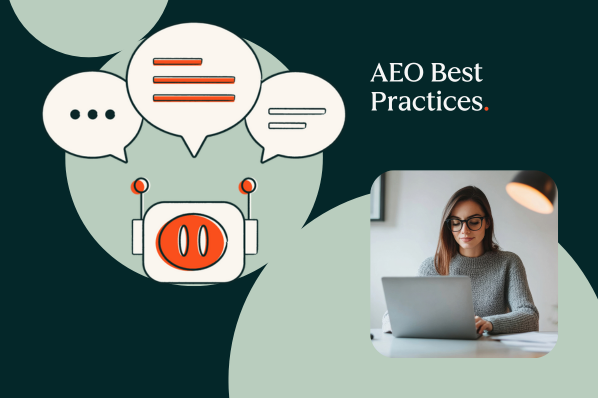AEO Best Practices Every Marketing Team Needs

▼ Summary
– Answer Engine Optimization (AEO) is the process of structuring content so AI systems like ChatGPT and Google AI Overviews can easily find, understand, and cite it as authoritative answers.
– AEO differs from traditional SEO by focusing on citations and zero-click visibility in AI responses rather than driving website traffic through clicks and rankings.
– Key AEO best practices include mapping user questions, structuring content for direct answers, implementing schema markup, and building credibility with citations and data.
– The rise of AI tools has shifted consumer behavior, with nearly 60% of Google searches now ending without a click as users get answers directly from AI summaries and featured snippets.
– AEO complements rather than replaces SEO, requiring a hybrid approach that combines traditional SEO foundations with new strategies for AI-driven discovery and brand visibility.
Answer Engine Optimization (AEO) represents the next evolution in digital marketing, shifting focus from driving clicks to securing brand citations within AI-generated responses. For marketing professionals accustomed to traditional SEO, this transition can feel unsettling. Yet the seismic shift in user behavior makes AEO implementation essential for maintaining visibility. Nearly 60% of Google searches now conclude without a click, while platforms like ChatGPT serve over 800 million weekly users seeking instant answers. Brands that fail to adapt risk becoming invisible in these answer-first environments.
My own journey into AEO began with professional uncertainty. Having built expertise in conventional SEO, mastering keywords, technical optimizations, and ranking strategies, I watched as AI tools began transforming how people find information. Where search engines once provided lists of resources, AI systems now deliver synthesized answers, fundamentally changing what visibility means. This evolution doesn’t render SEO obsolete but demands a complementary approach focused on making content machine-readable and citation-ready.
Understanding Answer Engine Optimization
Answer Engine Optimization involves structuring content so AI systems can easily extract, understand, and present it as authoritative answers. Whether someone asks ChatGPT for marketing strategies, queries Google’s AI Overviews for definitions, or requests local business hours from Alexa, AEO determines whether your content gets referenced.
The distinction between SEO and AEO lies in their primary objectives. Traditional SEO aims to rank highly in search engine results pages to generate website traffic. Success metrics include impressions, click-through rates, and organic sessions. AEO, conversely, prioritizes inclusion in AI-generated responses, often without driving clicks. Key performance indicators shift to citation rates, share of AI voice, and brand mentions within answer interfaces.
Consider how each approach handles a query about action movies. A search engine returns multiple resources for users to explore, while an answer engine compiles a definitive list from various sources. The strategic difference becomes visibility without traffic, your brand might be cited thousands of times in AI conversations without appearing in traditional analytics, yet still influence purchasing decisions where modern research begins.
Why AEO Demands Immediate Attention
The digital landscape is rapidly transitioning from click-based to answer-based interactions. Beyond Google’s reported 60% of zero-click searches, generative AI integration across platforms like Microsoft Copilot, Perplexity, and Gemini means users increasingly receive answers directly rather than visiting websites. Voice assistants further accelerate this trend by delivering concise responses, typically citing single sources.
This doesn’t negate SEO’s importance but recontextualizes it. AEO builds upon SEO fundamentals, quality content, domain authority, internal linking, while reorienting priorities toward machine-friendly formatting and answer-ready structures. Think of AEO as an additional layer to your content strategy rather than a replacement for existing efforts.
Essential AEO Implementation Strategies
1- Map User Questions Systematically
AEO success begins with understanding what your audience asks throughout their journey. Compile a comprehensive question inventory by consulting customer-facing teams and analyzing “People Also Ask” data from search results. Segment questions by funnel stage: awareness-stage queries need educational answers, consideration-stage questions require comparisons and proof points, while decision-stage inquiries demand specifics about implementation and pricing. Maintain this inventory in shared documentation, tracking coverage status and competitive gaps.
2- Structure Content for Direct Extraction
AI systems prioritize content organized for easy parsing. Begin each key section with a 40-60 word direct answer that fully addresses the question without preamble. Follow with supporting details for readers seeking depth. Implement scannable formatting through bullet points, numbered lists, and brief paragraphs. Develop reusable content blocks for definitions, step-by-step processes, and comparisons that serve as semantic signals for AI identification.
3- Implement Strategic Schema Markup
Structured data explicitly tells AI systems what your content represents. Focus on core schema types: FAQPage for question-answer pairs, HowTo for instructional content, Article for editorial pieces, and Speakable for voice-optimized sections. Organization schema sitewide clarifies brand identity. Content management systems with built-in schema tools can automate implementation across content types.
4- Capture Featured Snippets and PAA Positions
Featured snippets and “People Also Ask” boxes represent Google’s answer training ground. Content appearing here gains preferential treatment from AI systems. Match existing snippet formats, paragraph, list, or table, in your responses. Mirror question wording in headers and position answers prominently within the first two scrolls. Regularly harvest new PAA questions and update established pages rather than creating new content, as Google favors authoritative existing pages.
5- Establish Credibility Through Verification
Content incorporating citations, statistics, and expert quotes demonstrates approximately 30-40% higher visibility in AI results. Support all claims with verifiable data, preferably original research. Maintain high editorial standards and regularly update content with fresh information. Credibility signals significantly impact whether AI systems trust your content enough to cite it.
6- Build Multichannel Authority
AI systems determine credibility partly by evaluating brand presence across authoritative contexts. Develop a distribution strategy encompassing professional platforms like LinkedIn, video content with detailed transcripts, authentic participation in relevant forums, and contributed articles to reputable publications. Original research distributed across multiple channels creates citation opportunities that reinforce authority.
7- Optimize for Voice Responses
Voice assistants prioritize concise, unambiguous content formatted for spoken delivery. Write answers in natural language avoiding jargon and ambiguous references. Implement Speakable schema to designate voice-ready sections. Test queries across major assistants and establish CMS conventions for identifying voice-optimized content blocks.
8- Maintain Local Optimization
Local businesses must ensure consistent business information across platforms since AI frequently incorporates local results for seemingly non-local queries. Optimize Google Business Profiles with complete details, encourage customer reviews, create location-specific landing pages, and verify consistent Name-Address-Phone formatting across all directories.
Technical AEO Foundation
Technical implementation ensures AI systems can reliably access and interpret your content:
- Verify server-side rendering for critical content
- Use proper semantic HTML tags
- Achieve Core Web Vitals benchmarks
- Create descriptive URL slugs
- Maintain logical heading hierarchy
- Implement descriptive internal linking
- Test content accessibility without JavaScript
Overcoming Common AEO Challenges
Organizational resistance often presents the greatest barrier to AEO adoption. Frame AEO as brand awareness and category leadership rather than direct traffic generation. Develop hybrid measurement combining proxy metrics like featured snippet appearances with branded search volume and customer survey feedback.
For attribution difficulties, manually track citations across AI platforms while monitoring branded search trends. Prioritize content updates strategically, beginning with high-traffic pages and near-ranking content. Use schema templates to simplify implementation for non-technical teams.
Address algorithm volatility by anchoring strategy in stable principles: direct answering, clear structure, authority building, and semantic clarity. These fundamentals improve user experience regardless of platform changes.
AEO Integration with Modern Marketing
AEO naturally complements loop marketing strategies by enabling continuous engagement across multiple channels. Instead of assuming linear customer journeys, this approach meets buyers wherever they seek information, through AI assistants, social platforms, forums, or voice search. When your content gets cited as users explore new questions or compare options, you maintain top-of-mind awareness without relying on direct website visits.
The transition to answer-focused marketing doesn’t discard existing SEO expertise but repurposes it for new contexts. The same principles of clarity, structure, and audience understanding that drove SEO success now fuel AEO effectiveness. Rather than concerning yourself with declining click-through rates, concentrate on establishing your brand as the definitive source for answers in your domain.
(Source: HubSpot Marketing Blog)





